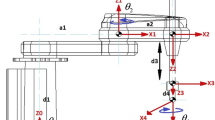Abstract
As kinematic calculations are complicated, it takes a long time and is difficult to get the desired accurate result with a single processor in real-time motion control of multi-degree-of-freedom (MDOF) systems. Another calculation unit is needed, especially with the increase in the degree of freedom. The main central processing unit (CPU) has additional loads because of numerous motion elements which move independently from each other and their closed-loop controls. The system designed is also complicated because there are many parts and cabling. This paper presents the design and implementation of a hardware that will provide solutions to these problems. It is realized using the Very High Speed Integrated Circuit Hardware Description Language (VHDL) and field-programmable gate array (FPGA). This hardware is designed for a six-legged robot and has been working with servo motors controlled via the serial port. The hardware on FPGA calculates the required joint angles for the feet positions received from the serial port and sends the calculated angels to the servo motors via the serial port. This hardware has a co-processor for the calculation of kinematic equations and can be used together with the equipment that would reduce the electromechanical mess. It is intended to be used as a tool which will accelerate the transition from design to application for robots.
Similar content being viewed by others
References
Axelson, J., 2007. Serial Port Complete: COM Ports, USB Virtual COM Ports, and Ports for Embedded Systems (2nd Ed.). Lakeview Research.
Barron-Zambrano, J.H., Torres-Huitzil, C., Girau, B., 2012. Configurable embedded CPG-based control for robot locomotion. Int. J. Adv. Robot. Syst., 9:92.1–92.12. [doi:10.5772/50985]
Erkol, H.O., Demirel, H., 2013. A serial port hardware design and application by FPGA. Turkish National Meeting on Automatic Control, p.132–135 (in Turkish).
Fang, Y., Chen, X., 2011. Design and simulation of UART serial communication module based on VHDL. Proc. 3rd Int. Workshop on Intelligent Systems and Applications, p.1–4. [doi:10.1109/ISA.2011.5873448]
Fongjun, T., Tantaworrasilp, A., Kwansud, P., et al., 2011. Automatic multi channel serial I/O interface using FPGA. Proc. SICE Annual Conf., p.864–867.
Hani, M.K., Wen, H.Y., Paniandi, A., 2006. Design and implementation of a private and public key crypto processor for next-generation IT security applications. Malaysian J. Comput. Sci., 19(1):29–45.
Idris, M.Y.I., Yaacob, M., Razak, Z., 2006. A VHDL implementation of UART design with BIST capability. Malaysian J. Comput. Sci., 19(1):73–86.
Juang, Y.S., Sung, T.Y., Ko, L.T., et al., 2013. FPGA implementation of a CORDIC-based joint angle processor for a climbing robot. Int. J. Adv. Robot. Syst., 10:195.1–195.6. [doi:10.5772/53377]
Mahapatra, A., Roy, S.S., 2009. Computer aided dynamic simulation of six-legged robot. Int. J. Recent Trends Eng., 2(2):146–151.
Murray, R.M., Li, Z., Sastry, S.S., 1994. A Mathematical Introduction to Robotic Manipulation. CRC Press, Boca Raton, Florida, USA.
Pa, P.S., Wu, C.M., 2012. Design of a hexapod robot with a servo control and a man-machine interface. Robot. Comput.-Integr. Manuf., 28(3):351–358. [doi:10.1016/j.rcim.2011.10.005]
Roennau, A., Kerscher, T., Dillmann, R., 2010. Design and kinematics of a biologically-inspired leg for a six-legged walking machine. Proc. 3rd IEEE RAS and EMBS Int. Conf. on Biomedical Robotics and Biomechatronics, p.626–631. [doi:10.1109/BIOROB.2010.5626328]
Sandoval-Castro, X.Y., Garcia-Murillo, M., Perez-Resendiz, L.A., et al., 2013. Kinematics of hex-piderix—a six-legged robot—using screw theory. Int. J. Adv. Robot. Syst., 10:19.1–19.8. [doi:10.5772/53796]
Shih, T.S., Tsai, C.S., Her, I., 2012. Comparison of alternative gaits for multiped robots with severed legs. Int. J. Adv. Robot. Syst., 9:157.1–157.8. [doi:10.5772/52083]
Siciliano, B., Sciavicco, L., Villani, L., et al., 2009. Robotics Modelling, Planning and Control. Springer, London, UK. [doi:10.1007/978-1-84628-642-1]
Taira, T., Kamata, N., Yamasaki, N., 2005. Design and implementation of reconfigurable modular humanoid robot architecture. IEEE/RSJ Int. Conf. on Intelligent Robots and Systems, p.3566–3571. [doi:10.1109/IROS.2005.1545122]
Zheng, Y., Liu, J., Kan, J., 2012. An optimal kinematics calculation method for a multi-DOF manipulator. Przegląd Elektrotechn., 88(7b):320–323.
Zhu, W., Lamarche, T., Dupuis, E., et al., 2013. Precision control of modular robot manipulators: the VDC approach with embedded FPGA. IEEE Trans. Robot., 29(5):1162–1179. [doi:10.1109/TRO.2013.2265631]
Author information
Authors and Affiliations
Corresponding author
Additional information
Project (No. KBÜ-BAP-13/1-DR-011) supported by the Department of Bilimsel Araştirma Progeleri, Karabük University, Turkey
ORCID: Hüseyin Oktay ERKOL, http://orcid.org/0000-0002-3595-175X
Rights and permissions
About this article
Cite this article
Erkol, H.O., Demirel, H. A VHDL application for kinematic equation solutions of multi-degree-of-freedom systems. J. Zhejiang Univ. - Sci. C 15, 1164–1173 (2014). https://doi.org/10.1631/jzus.C1400120
Received:
Revised:
Published:
Issue Date:
DOI: https://doi.org/10.1631/jzus.C1400120




